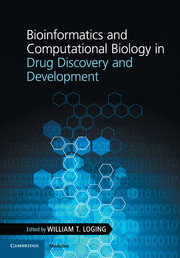Book contents
- Frontmatter
- Contents
- List of contributors
- Foreword: The future of drug discovery and healthcare
- Acknowledgments
- 1 The art and science of the drug discovery pipeline
- 2 Computational approaches to drug target identification
- 3 Understanding human disease knowledge through text mining
- 4 Integrating translational biomarkers into drug development
- 5 Computational phenotypic assessment of small molecules in drug discovery
- 6 Data visualization and the DDP process
- 7 Information visualization – important IT considerations
- 8 Example of computational biology at the new drug application (NDA) and regulatory approval stages
- 9 Clinical trial failures and drug repositioning
- Appendix I Additional knowledge-based analysis approaches
- Appendix II Open source tools and public data sources
- Index
- Plate section
- References
4 - Integrating translational biomarkers into drug development
Published online by Cambridge University Press: 05 February 2016
- Frontmatter
- Contents
- List of contributors
- Foreword: The future of drug discovery and healthcare
- Acknowledgments
- 1 The art and science of the drug discovery pipeline
- 2 Computational approaches to drug target identification
- 3 Understanding human disease knowledge through text mining
- 4 Integrating translational biomarkers into drug development
- 5 Computational phenotypic assessment of small molecules in drug discovery
- 6 Data visualization and the DDP process
- 7 Information visualization – important IT considerations
- 8 Example of computational biology at the new drug application (NDA) and regulatory approval stages
- 9 Clinical trial failures and drug repositioning
- Appendix I Additional knowledge-based analysis approaches
- Appendix II Open source tools and public data sources
- Index
- Plate section
- References
Summary
Drug development is notoriously slow and arduous in comparison to other high-tech industries. The raw nature of biology makes it very difficult to rapidly prototype and iterate in ways that are normally much faster in other technology spaces. Layer on top of the lengthy screening processes and multi-year, multi-million dollar clinical trials an enormous regulatory burden and you end up with development times in excess of 10 years on average from concept to product (Lipsky and Sharp, 2001). Contrast this to the smartphone industry, where a new hardware prototype can be in stores within nine months from the first mockup. Even faster, OS releases can sometimes turn around in 90 days. Granted, the improvement increments may be measured on different scales in pharmaceuticals and consumer electronics, but the key driver of innovation is the iterative cycle.
It is not surprising that the pharmaceutical industry has turned to computational approaches in order to compress the lag experienced between bench and bedside. With so much riding on a single molecule to perform in clinical trials and deliver the most promising product possible, early characterization of drug candidates can make or break the next blockbuster. Drug candidate identification and optimization has seen benefit from process automation, but prediction of which targets and drugs will perform well enough to provide a positive risk–benefit is still not possible.
Biomarkers are tools applied to study exploratory pharmaceuticals, which help scientists and clinicians better understand the trajectory of a developing drug. Historically, drugs were developed almost exclusively using empirical data to evaluate the risk–benefit profile. The use of biomarkers in drug development has driven a trend toward more quantitative, evidence-based drug development. This trend has also fueled the promises of personalized medicine and the companion diagnostics industry. Importantly, incorporating biomarker information throughout the drug development process has led to an increase in confidence to accelerate or abandon certain experimental therapeutics. The FDA's Critical Path Initiative has driven regulatory interest in using biomarker evidence to add greater confidence in bringing new therapeutics to unmet medical needs (Woodcock and Woosley, 2008). While the emerging trend to use biomarkers has provided plenty of buzz around precision medicine, sifting through all the information to find the right conclusions can be a new challenge stemming from the mountains of data being generated in response. Here is where “Big Data” meets “Big Pharma.”
Information
- Type
- Chapter
- Information
- Publisher: Cambridge University PressPrint publication year: 2016
